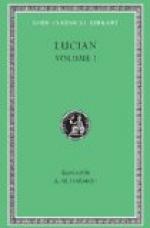The game commences at this point. The whole line of players passes, or pretends to pass, this bone on from one to another, until at last every hand is waving. All this time the eyes along the opposite line of gamblers are eagerly watching each shift and movement of the hands, in hopes of discovering the white flash of the bone. At last some one descries the hand that holds the bone, or thinks so. He points out and calls out for his side. The hand must instantly be thrown up. If it is right, the watching side scores a point and takes the bone. The sides change off in this way until the game is won. The full score is twenty-one points. The excitement produced by this game is at times simply indescribable.
The Utes play with two bones in each hand, one of which is wrapped about with a string. The game is to guess the hand that holds the wrapped bone. The plum-stone game is played by the plains Indians. It is only another name for dice throwing. The plum-stones are graved with hieroglyphics, and counts are curiously made in a way that often defies computation by white men. The women gamble quite as much as the men, when they dare, and grow even more excited over the game than their lords. Their game, as witnessed among the Cheyennes, is played with beads, little loops and long horn sticks made of deer foot.
The children look on and learn to gamble from their earliest childhood, and soon learn to cheat and impose on their juniors. Their little juvenile gambling operations are done principally with arrows. Winter breeds sloth, and sloth begets gambling, and gambling, drink. There is no conviviality in Indian drinking bouts. The Indian gets drunk, and dead drunk, as soon as he possibly can, and finds his highest enjoyment in sleeping it off. His nature reacts viciously under drink, however, in many cases, and he is then a dangerous customer.
The women of many tribes are a most pitiable lot of hard working, ragged and dirty humanity. Upon them falls all the drudgery of the camp; they are “hewers of wood and drawers of water,” and bend under immense burdens piled upon their backs, while thousands of ponies browse, undisturbed, in every direction. As the troops are withdrawn, the squaws swoop down upon the deserted camps, and rapidly glean them of all that is portable, for use in their domestic economy. An Indian fire would be considered a very cheerless affair by the inmates of houses heated by modern appliances; but such as it is—a few sticks burning with feeble blaze and scarcely penetrating the dense smoke filling the tepee from the ground to the small opening at the top—it consumes fuel, and the demand is always greater than the supply, for the reason that an Indian has no idea of preparation for future necessities. If the fire burns, all right; when the last stick is laid on, a squaw will start for a fresh supply, no matter how cold and stormy the weather may be.
The poetical Indian maiden may still exist in the vivid imagination of extreme youth, but she is not common to-day. The young girls affect gay attire, and are exempt from the hardships of toil which are imposed on their elder sisters, mothers and grandams, but their fate is infinitely worse. Little beauty is to be discerned among them, and in this regard time seems to have effaced the types which were prevalent a few years ago.




